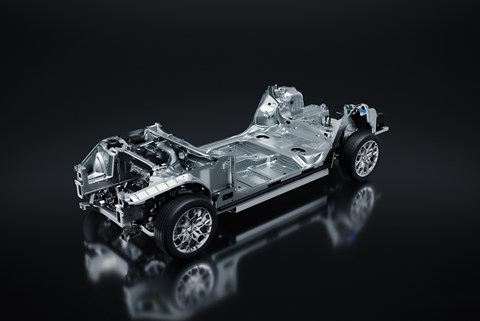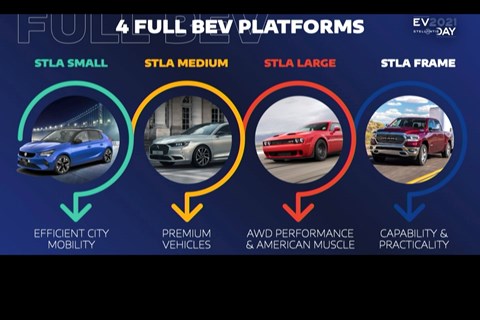► Details on Stellantis’ STLA platforms
► Small, Medium, Large and Frame versions
► More production details of Large revealed
Automotive mega-group Stellantis is in the process of rolling out its wave of new ‘EV native’ STLA platforms across all of its major brands. The four STLA platforms (Small, Medium, Large and Frame) are designed to unify all its brands under a set of architectures based on size.
The latest to launch is STLA Large, set to start being deployed in cars launching in 2024. Stellantis says Large will be used for upcoming ‘D and E-segment’ cars by Alfa Romeo, Chrysler, Dodge, Jeep and Maserati – and one of the first cars to deploy the platform will be Jeep’s Wagoneer S SUV. In fact, eight car launches using STLA Large will happen between now and 2026.
STLA Large is designed to be ultra-flexible, offering both 400- and 800-volt architectures, and has been designed to cater to high-performance cars as well as properly capable off-roaders. Front-, rear- and all-wheel drive configurations are possible using Stellantis’ own ‘EDM’ electric motors.

As for power and performance, this is where Stellantis seems to be hitting a home run. Battery sizes of between 85 and 118kWh are possible, with up to 500 miles of range claimed for the sleekest and lowest saloons that will use STLA Large (like the upcoming replacement for the Alfa Romeo Giulia expected from 2025).
On top of that, Stellantis says cars running on STLA Large could sprint to 62mph in as little as two seconds, and points out that the most potent cars running on STLA Large ‘will outperform any of the existing Hellcat V8s.’ And, as the platform is described as ‘EV native,’ Stellantis says combustion and hybrid powertrains can be deployed for certain markets that are slower to take up EVs.
Having an 800-volt architecture as an option also allows cars running STLA Large to collect 4.5kWh of battery charge per minute.

The four physical platforms are named Small, Medium, Large and Frame.
STLA Small will benefit all brands that have city cars and superminis in their portfolios. This platform allows for battery capacities between 37 and 82kWh, with a range target of 300 miles. New EVs expected to use this platform include the next generation of small cars from the likes of Opel/Vauxhall, Peugeot, Fiat and Citroen. Carlos Tavares has said that we may see cars running on STLA Small ‘maybe by 2026 or 2027.’
STLA Medium is for mid-size cars and crossovers. The first car using STLA Medium – the new Peugeot e-3008 is already hitting dealerships, with more cars using Medium to come very soon. Battery ranges were originally planned to be between 87 and 104kWh when first announced in 2021, but the aforementioned Peugeot uses a smaller 74kWh pack.
STLA Large is likely going to be the most flexible and will benefit Stellantis brands across both sides of the Atlantic. Battery densities range between 85kWh and 118kWh, and the group says models on this platform will be capable of 500 miles or acceleration times as low as two seconds. Both 400- and 800-volt architectures are possible.
On top of these three monocoque platforms, STLA Frame is designed for the largest SUVs and pickup trucks. As the name suggests, it’s a body-on-frame platform – a design still prevalent in brands like Jeep and RAM, for example – with a battery pack inset between the structure. Again, Stellantis is targeting a maximum 500-mile range from battery capacities ranging between 159kWh and more than 200kWh.
As for the powertrains, Stellantis announced in 2021 that it will use three separate electronic drive modules. EDM 1 will be 400V and put out 70kW (93bhp) per unit, making it light and handy for small city cars that don’t require much power, or around 186bhp if applied to each axle for electric all-wheel drive. EDM 2, too, is 400V and can range in power from 125kW to 180kW (164bhp to 241bhp). EDM 3 can work with either a 400V or 800V electronic architecture, delivering between 150kW and 330kW (201bhp to 443bhp).